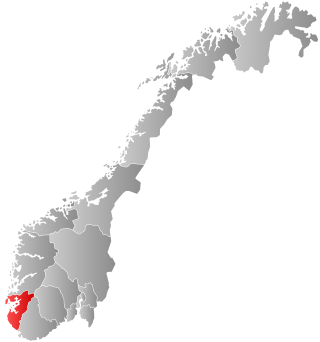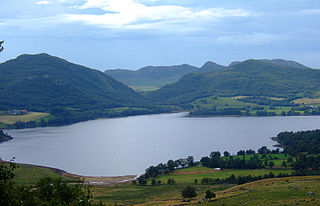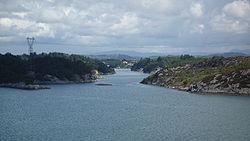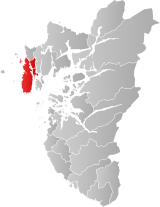
Rogaland is a county in Western Norway, bordering the North Sea to the west and the counties of Vestland to the north, Telemark to the east and Agder to the east and southeast. As of 1 January 2024, it had a population of 499,417 people.

Bokn is a municipality in Rogaland county, Norway. It is located in the traditional district of Haugaland. The administrative centre of the municipality is the village of Føresvik, the only urban area in Bokn. Other villages in Bokn include Arsvågen, Trosnavåg, and Loten. The island municipality is mostly located on the three islands of Ognøya, Vestre Bokn, and Austre Bokn. All three main islands are connected to the mainland via a network of bridges.

Haugesund ( ) is a municipality and town on the North Sea in Rogaland county, Norway. As of December 2023, the municipality of Haugesund has a population of 37,855. The vast majority of the population (37,008) live in the Haugesund urban area in the municipality's southwest. The Haugesund urban area also extends into neighboring Karmøy municipality and has a combined population of 46,359. Haugesund is the main commercial and economic centre of the Haugaland region in northern Rogaland and southern Vestland. The majority of the municipality outside this area is rural or undeveloped.

Sokndal is the southernmost municipality in Rogaland county, Norway. It is located in the traditional district of Dalane. The administrative centre of the municipality is the village of Hauge. Other villages in Sokndal include Li, Rekefjord, Sogndalsstranda, and Åna-Sira.

Lund is a municipality in Rogaland county, Norway. It is located in the traditional district of Dalane. The administrative centre of the municipality is the village of Moi. Other villages in Lund include Eik and, Heskestad. European route E39 and the Sørlandet Line both pass through Lund. Moi Station is a railway station in Lund.

Gjesdal is a municipality in Rogaland county, Norway. It is located in the traditional district of Jæren. The administrative centre of the municipality is the village of Ålgård. Other villages in Gjesdal include Dirdal, Frafjord, Gilja, Gjesdal, and Oltedal. The municipality lies about 25 kilometres (16 mi) to the southwest of the city of Stavanger in southwestern Norway.

Randaberg is a municipality in Rogaland county, Norway. It is located in the traditional district of Jæren, at the northern end of the Stavanger Peninsula. The administrative centre of the municipality is the village of Randaberg.

Finnøy is a former municipality in Rogaland county, Norway. The 104 square kilometres (40 sq mi) island municipality existed from 1838 until its dissolution in 2020 when it was merged into Stavanger Municipality. It was located in the traditional district of Ryfylke. The administrative centre of the municipality was the village of Judaberg.

Tysvær is a municipality in Rogaland county, Norway. It is part of the Haugalandet region. The municipality is located on the Haugalandet peninsula on the northern side of the Boknafjorden, just east of the towns of Kopervik and Haugesund. The administrative centre of the municipality is the village of Aksdal. Other villages in the municipality include Dueland, Førre, Grinde, Hervik, Hindaråvåg, Nedstrand, Skjoldastraumen, Susort, Tysvær, and Yrke.

Sveio is a municipality in Vestland county, Norway. Sveio is a border district that is sometimes considered to be located in the traditional district of Haugalandet since it is located on the Haugalandet peninsula, but it is also considered to be in the traditional district of Sunnhordland since it is located in southern Hordaland county. The administrative centre of the municipality is the village of Sveio. Other villages in the municipality include Auklandshamn, Førde, Våga, and Valevåg.

Eide is a former municipality in Møre og Romsdal county, Norway. It was part of the region of Nordmøre. It was located on the Romsdal peninsula, along the Kornstadfjorden and the Kvernesfjorden. The administrative centre of the municipality was the village of Eide. Other villages included Lyngstad, Vevang, and Visnes.

Kopervik is the largest town on the island of Karmøy in Rogaland county, Norway. It is also the administrative centre of the municipality of Karmøy. It is part of the traditional district of Haugaland. The town was also an independent municipality from 1866 until 1965.

is a town in Karmøy municipality in Rogaland county, Norway. It is located on the southernmost tip of the island of Karmøy at the entrance to the Boknafjorden and Karmsundet strait. The town is part of the traditional district of Haugaland. The town was an independent municipality due to its status as a ladested from 1858 until 1965.

or Åkrahamn is a small town in Karmøy municipality in Rogaland county, Norway. The town is located on the west side of the island of Karmøy in the traditional district of Haugaland. The town sits about 5 kilometres (3.1 mi) west of the town of Kopervik, about 12 kilometres (7.5 mi) north of the town of Skudeneshavn, and about 25 kilometres (16 mi) southwest of the town of Haugesund. The village of Veavågen lies immediately to the northeast of Åkrehamn.

Skudenes is a former municipality in Rogaland county, Norway. It was part of the traditional district of Haugaland. The 68-square-kilometre (26 sq mi) municipality existed from 1838 until its dissolution in 1965. The administrative centre was the town of Skudeneshavn. The municipality originally encompassed land that is now part of the municipalities of Bokn and Karmøy. It included the southern part of the island of Karmøy and the three islands to the east: Vestre Bokn, Austre Bokn, and Ognøya. In 1849, the three smaller islands were separated to form Bokn municipality.

Stangaland is a former municipality in Rogaland county, Norway. It was part of the traditional district of Haugaland. The municipality of Stangaland existed from 1909 until 1965 when it was merged into the newly created Karmøy Municipality. The 28-square-kilometre (11 sq mi) municipality encompassed the rural areas surrounding the coastal city of Kopervik on the island of Karmøy. The administrative centre was the village of Stangaland just outside the town of Kopervik.

Torvastad is a former municipality in Rogaland county, Norway. The municipality existed from 1838 until 1965. The administrative centre was the village of Haugesund, and after that it was the village of Torvastad on the island of Karmøy. Today, the area of Torvastad refers to the northern part of the municipality of Karmøy.

Åkra is a former municipality in the traditional district of Haugaland in Rogaland county, Norway. The 33-square-kilometre (13 sq mi) municipality existed from 1892 until 1965 and it encompassed the central part of the western coast of the island of Karmøy. The administrative centre was the village of Åkrehamn.

Avaldsnes is a former municipality in Rogaland county, Norway. The 126-square-kilometre (49 sq mi) municipality existed from 1838 until 1965 when it was dissolved. The area was an ancient centre of power on the west coast of Norway and is the site of one of Norway's more important areas of cultural history. The administrative centre of the municipality was the village of Avaldsnes. The municipality encompassed the area surrounding the Førresfjorden and the area surrounding the central part of the Karmsundet strait, plus the central part of the island of Karmøy. Today, the area is part of the municipalities of Tysvær and Karmøy.

Karmøy is an island in the northwestern part of Rogaland county, Norway. The 176.8 square kilometres (68.3 sq mi) island makes up the majority of the municipality of Karmøy, along with the islands of Feøy, some smaller surrounding islands, and part of the mainland south of the municipality of Haugesund. It is the largest island in Rogaland county. The island is separated from the mainland by the Karmsundet strait. The Boknafjorden lies to the south and southeast of the island. The Sirafjorden lies to the west, separating Karmøy from the islands of Utsira and Feøy.






























